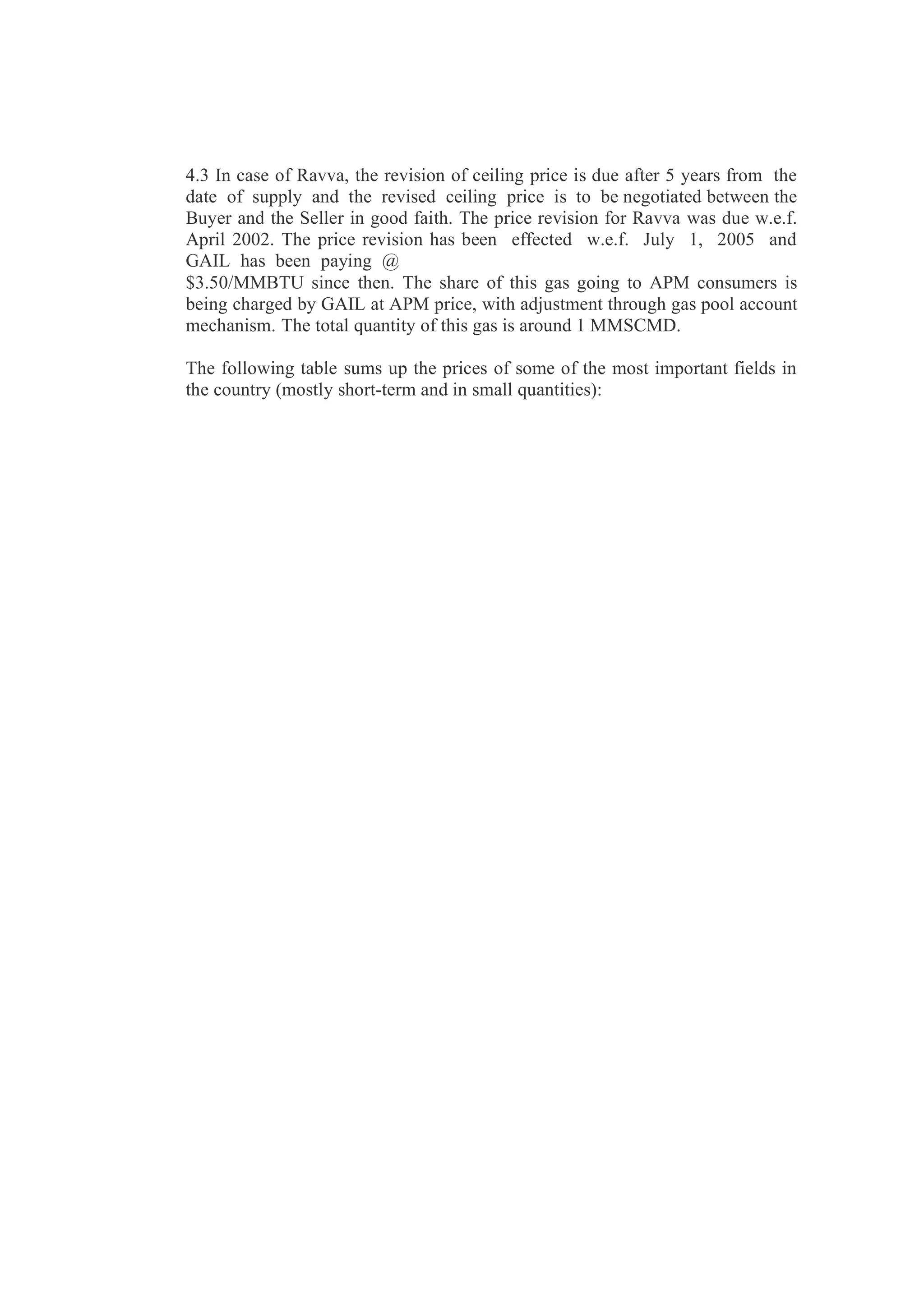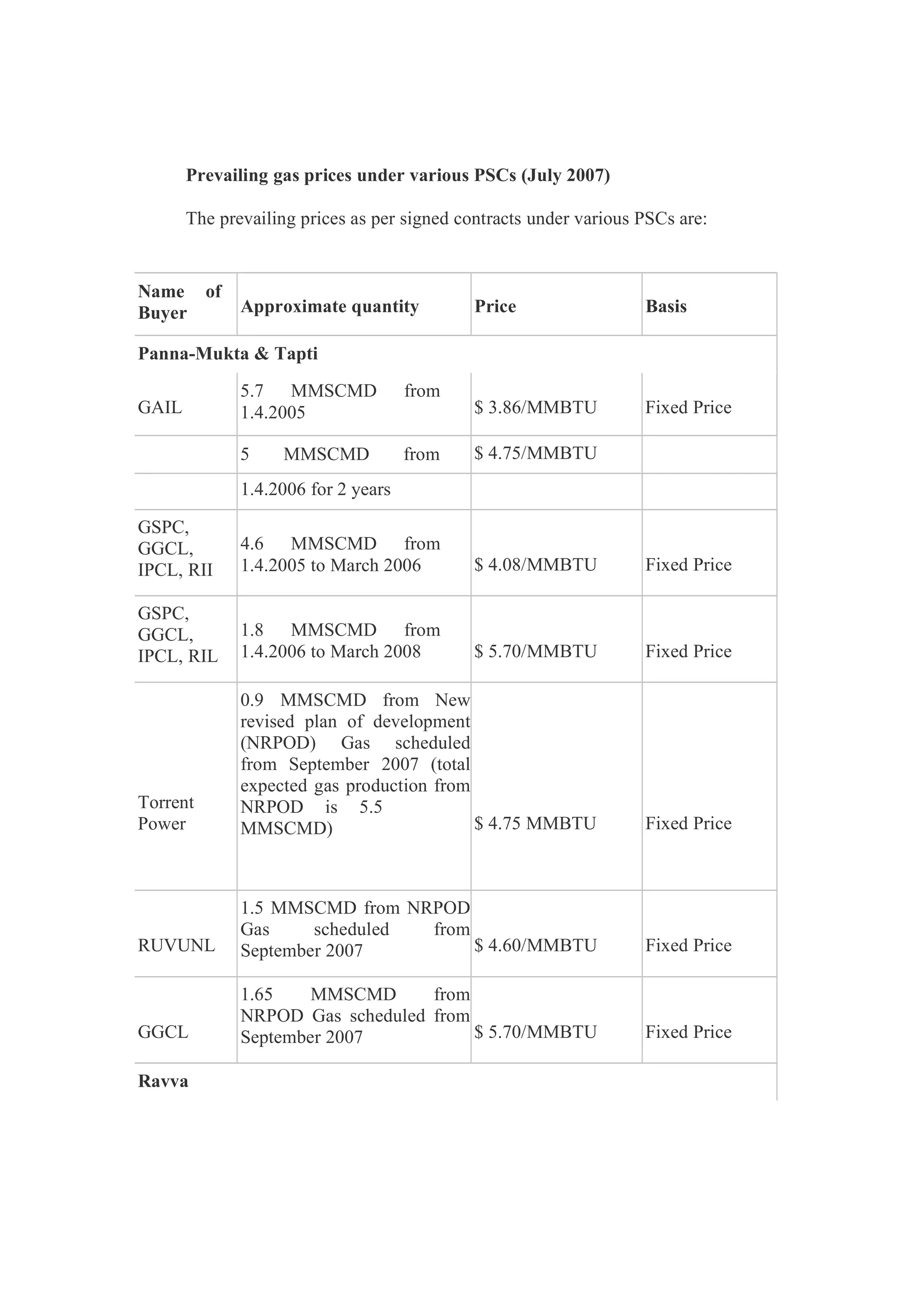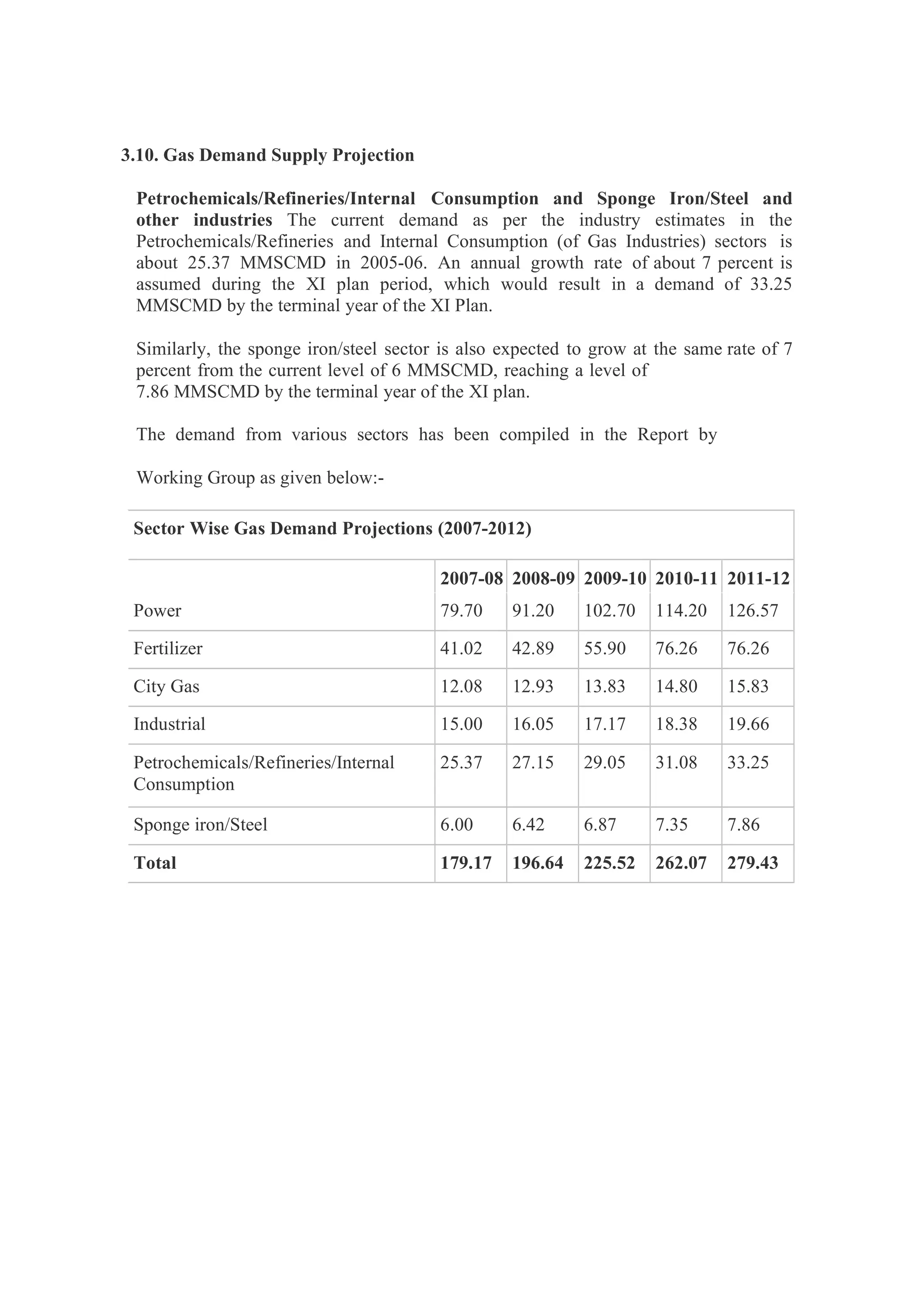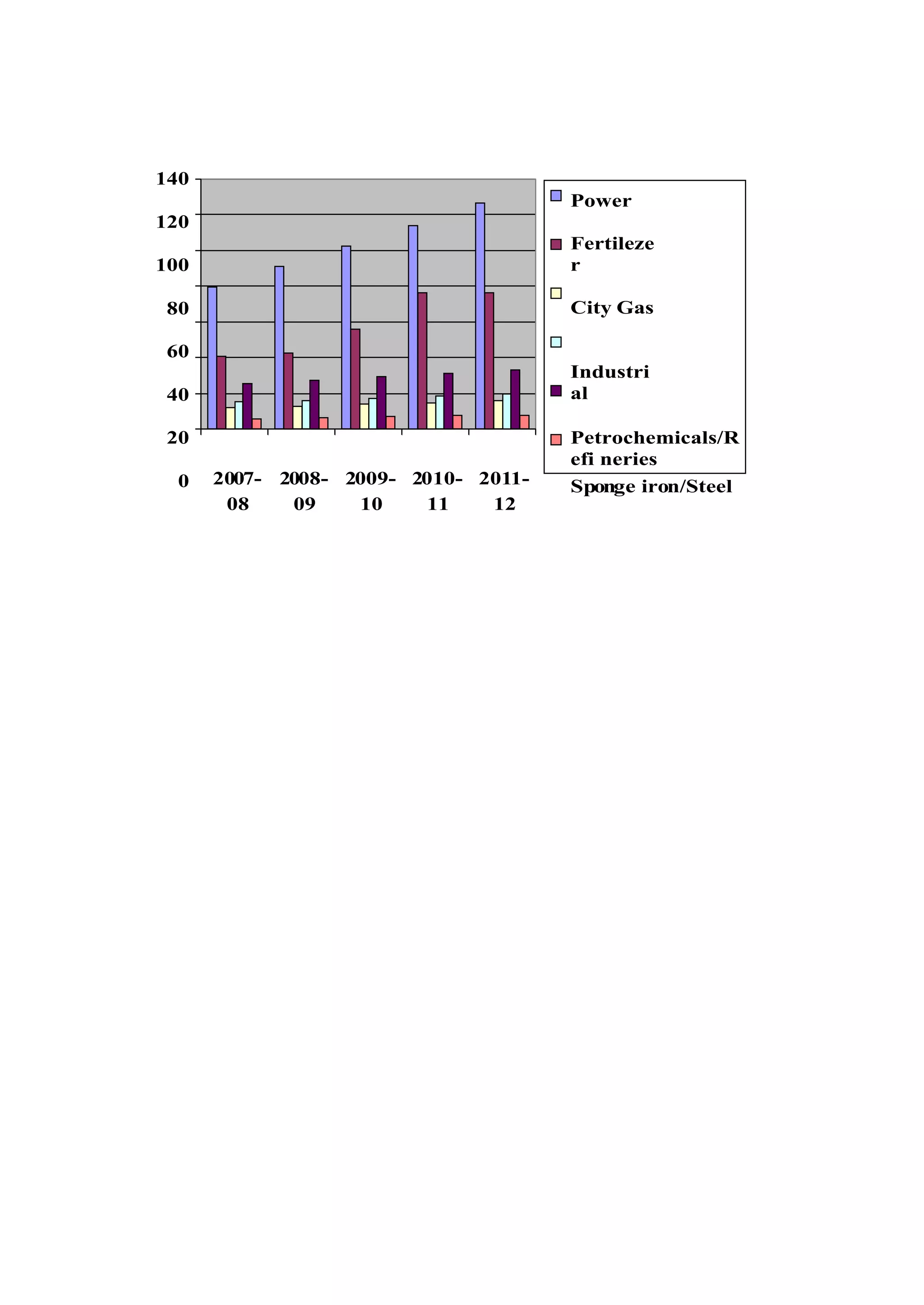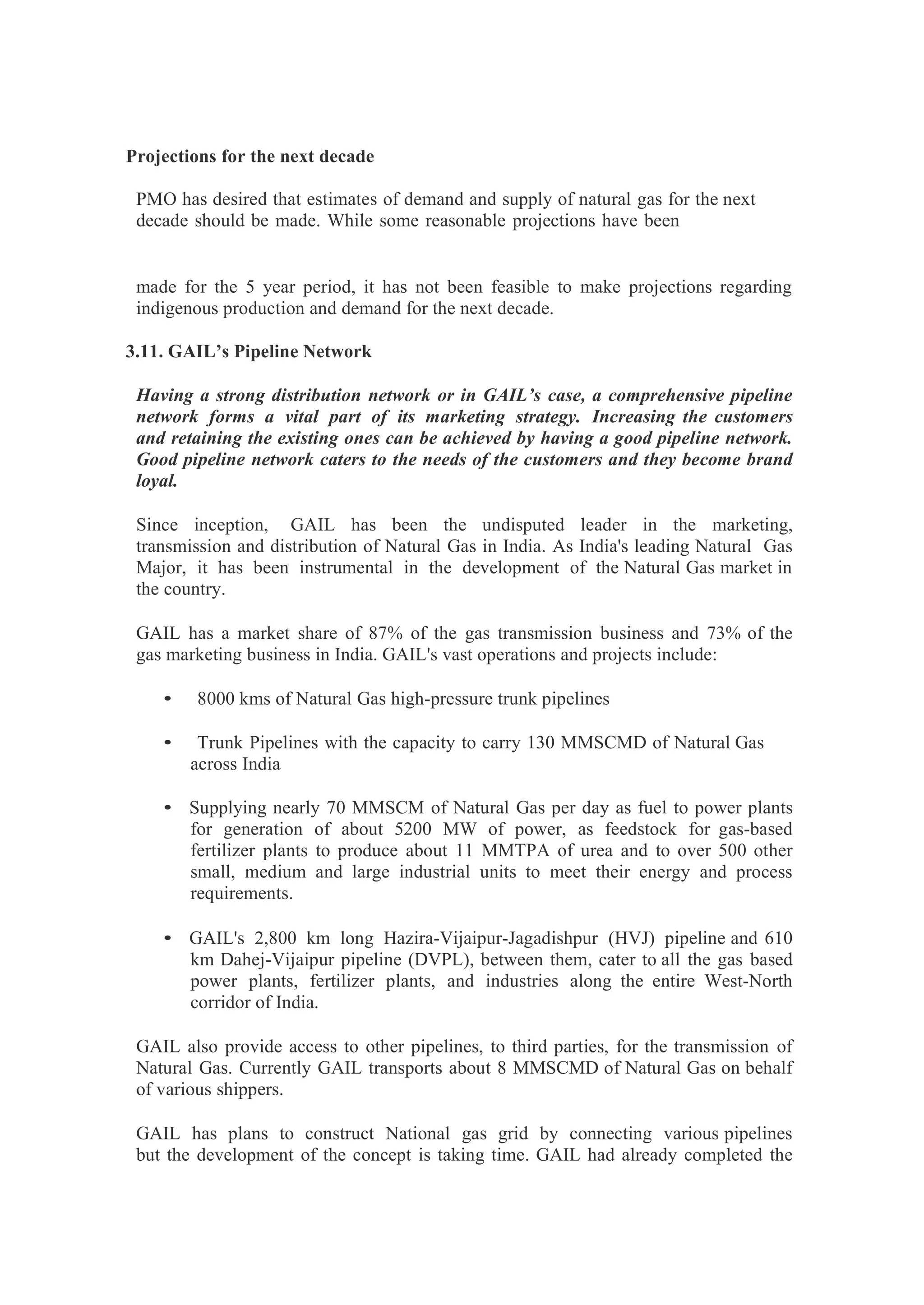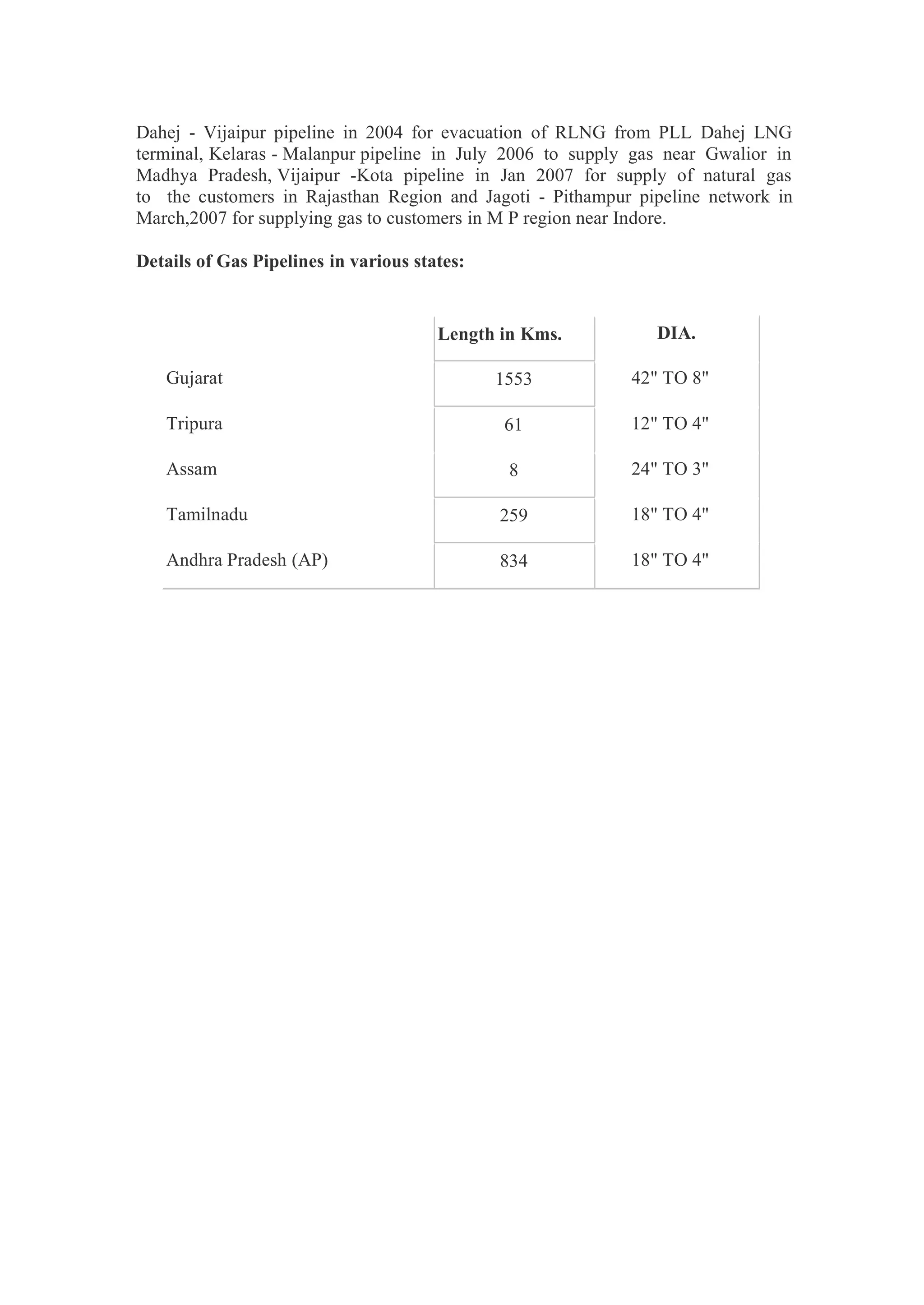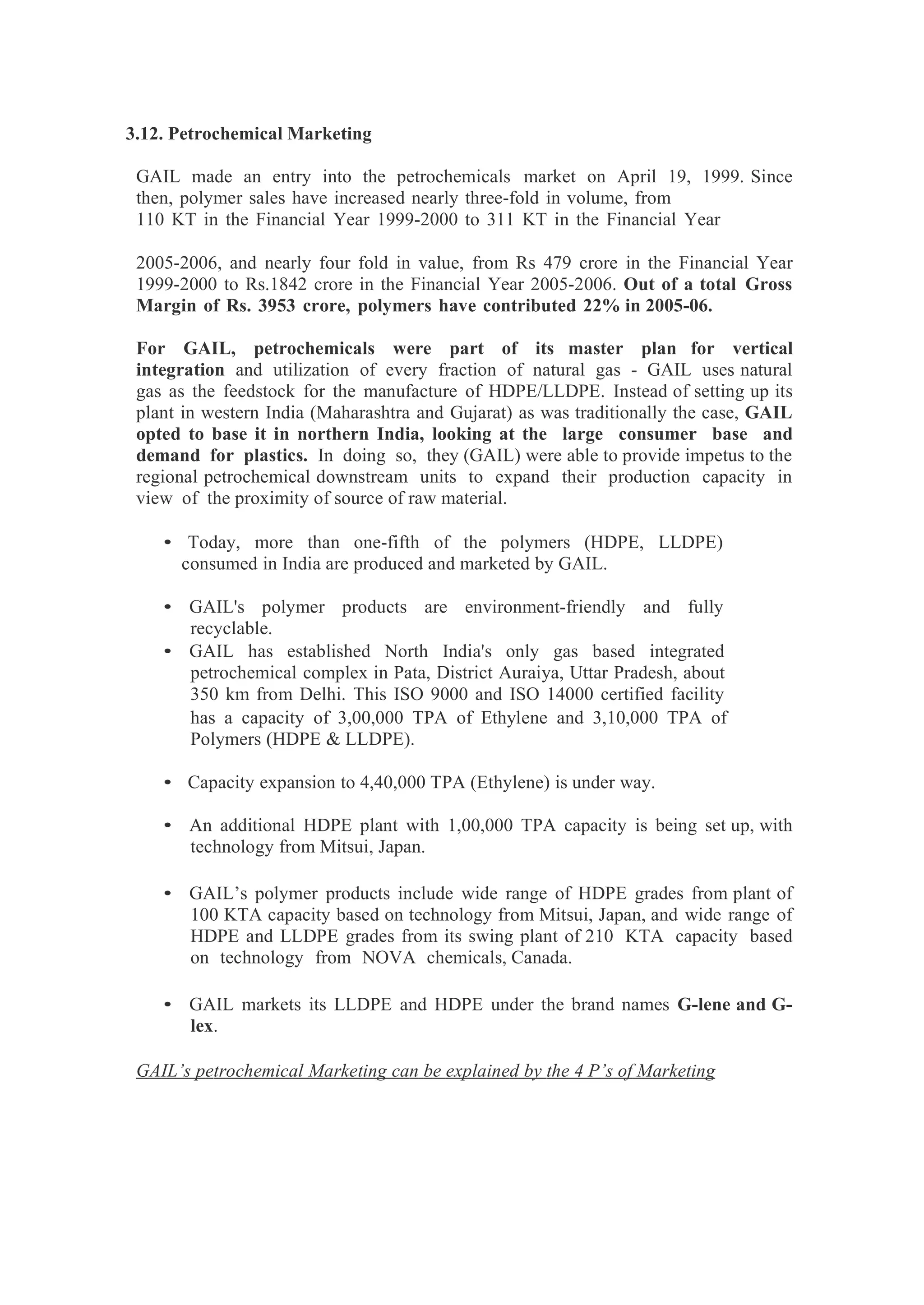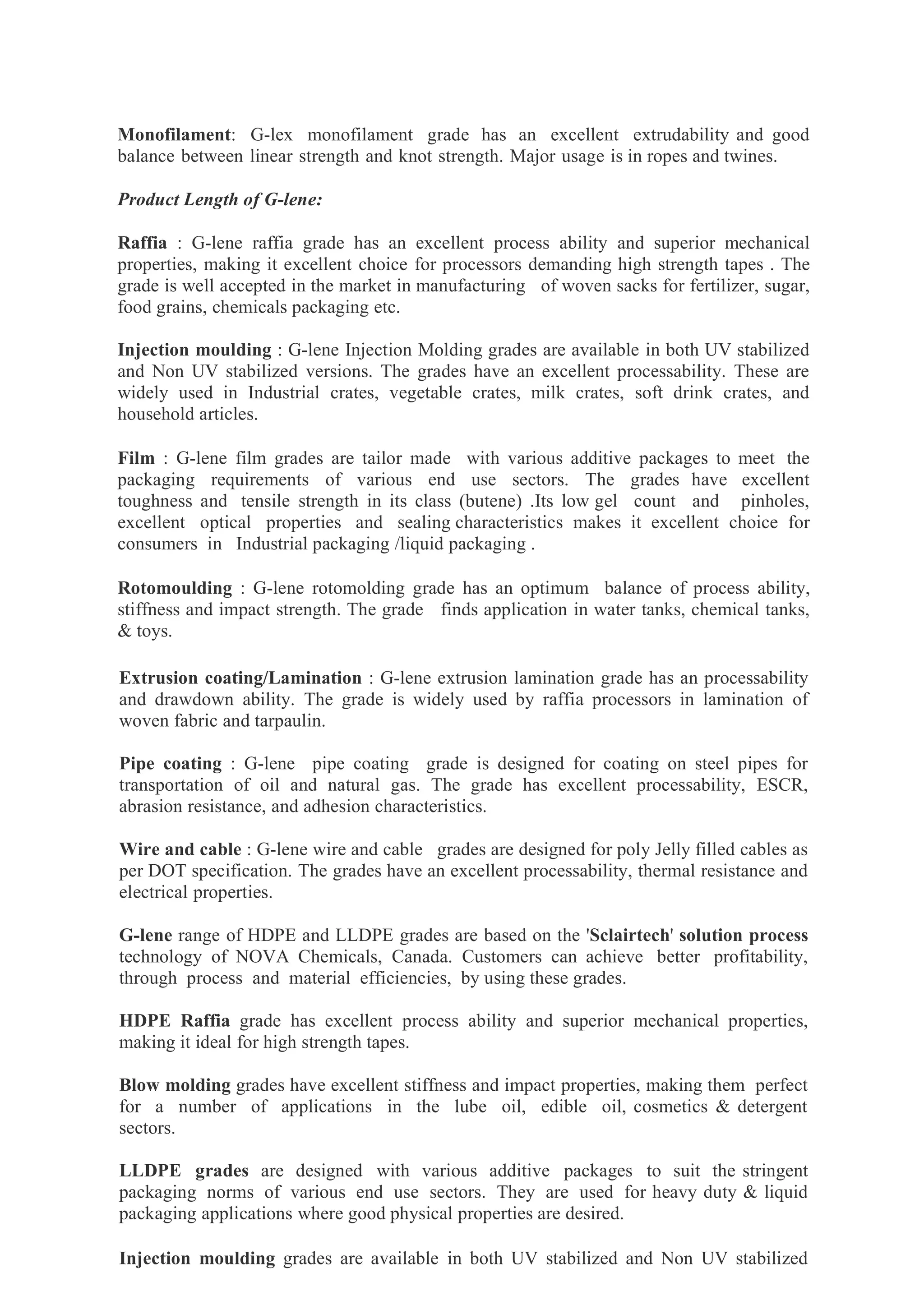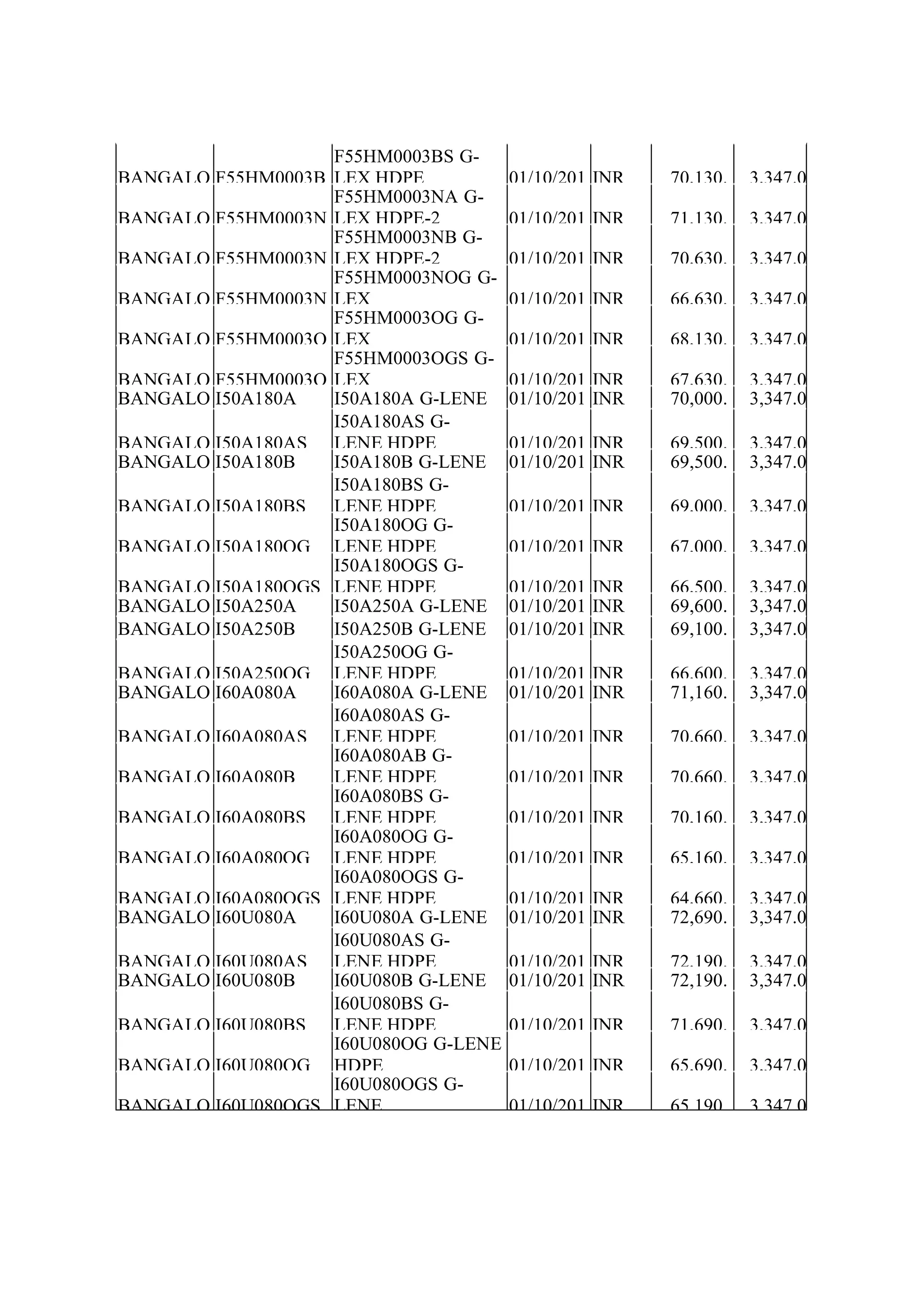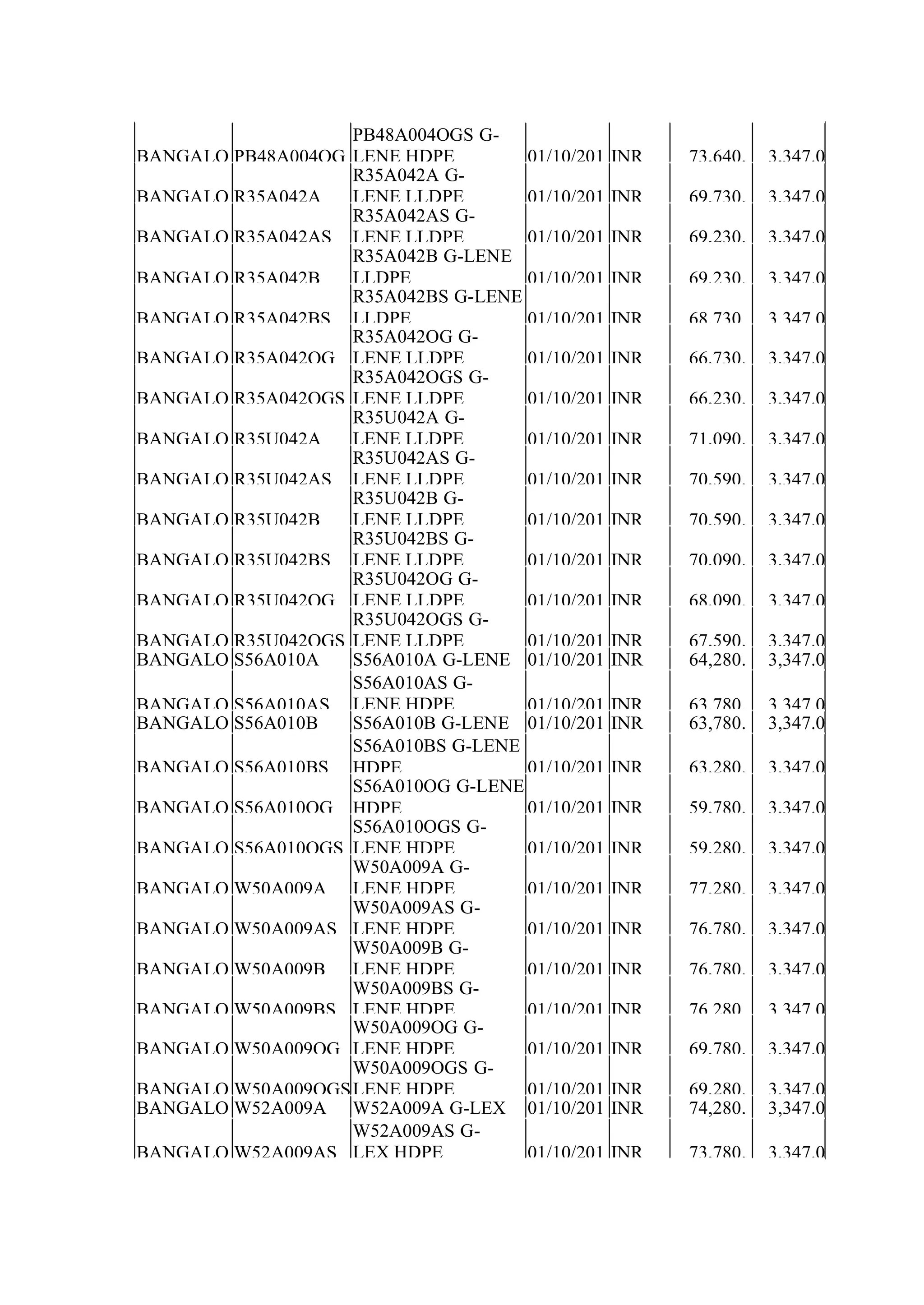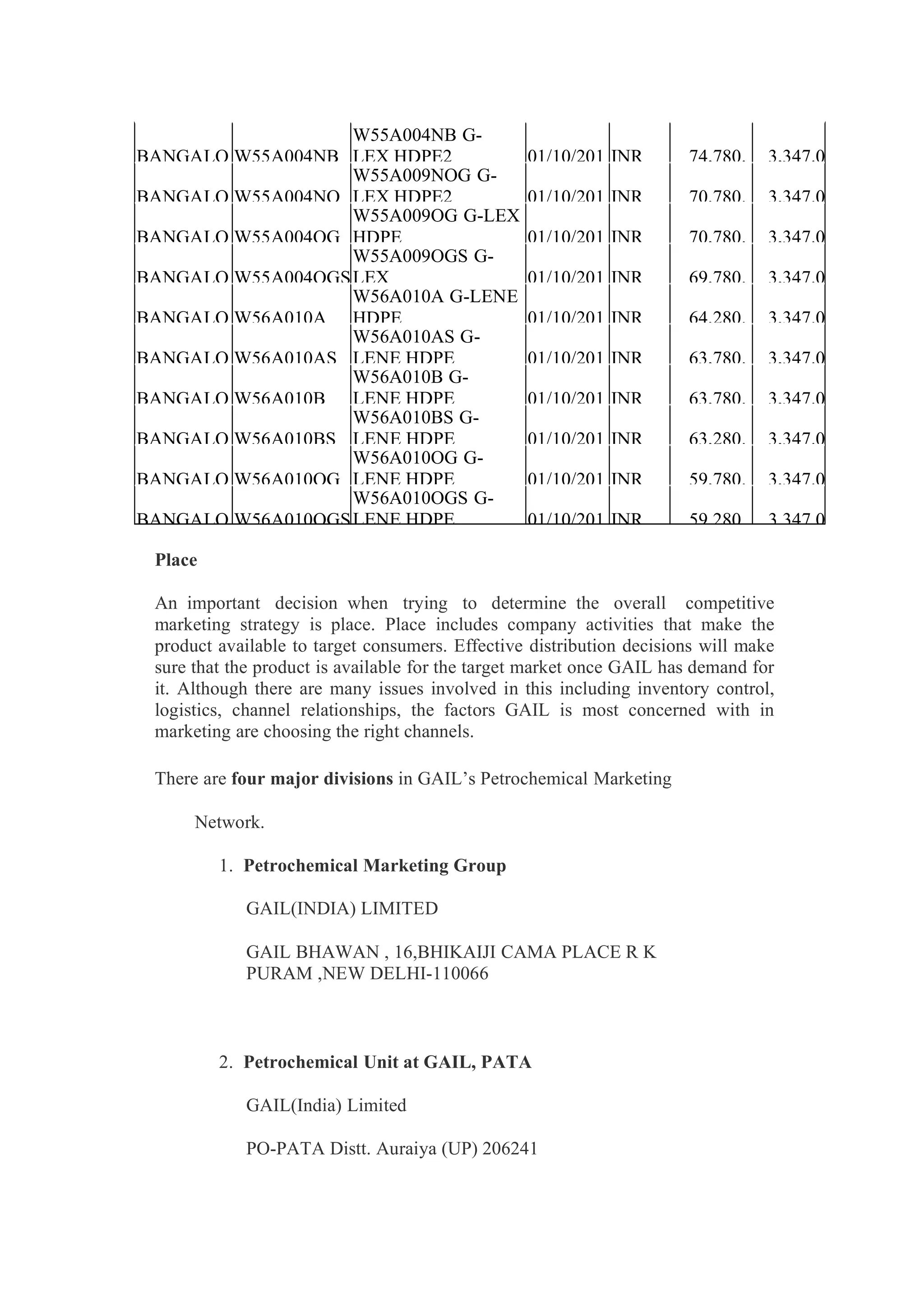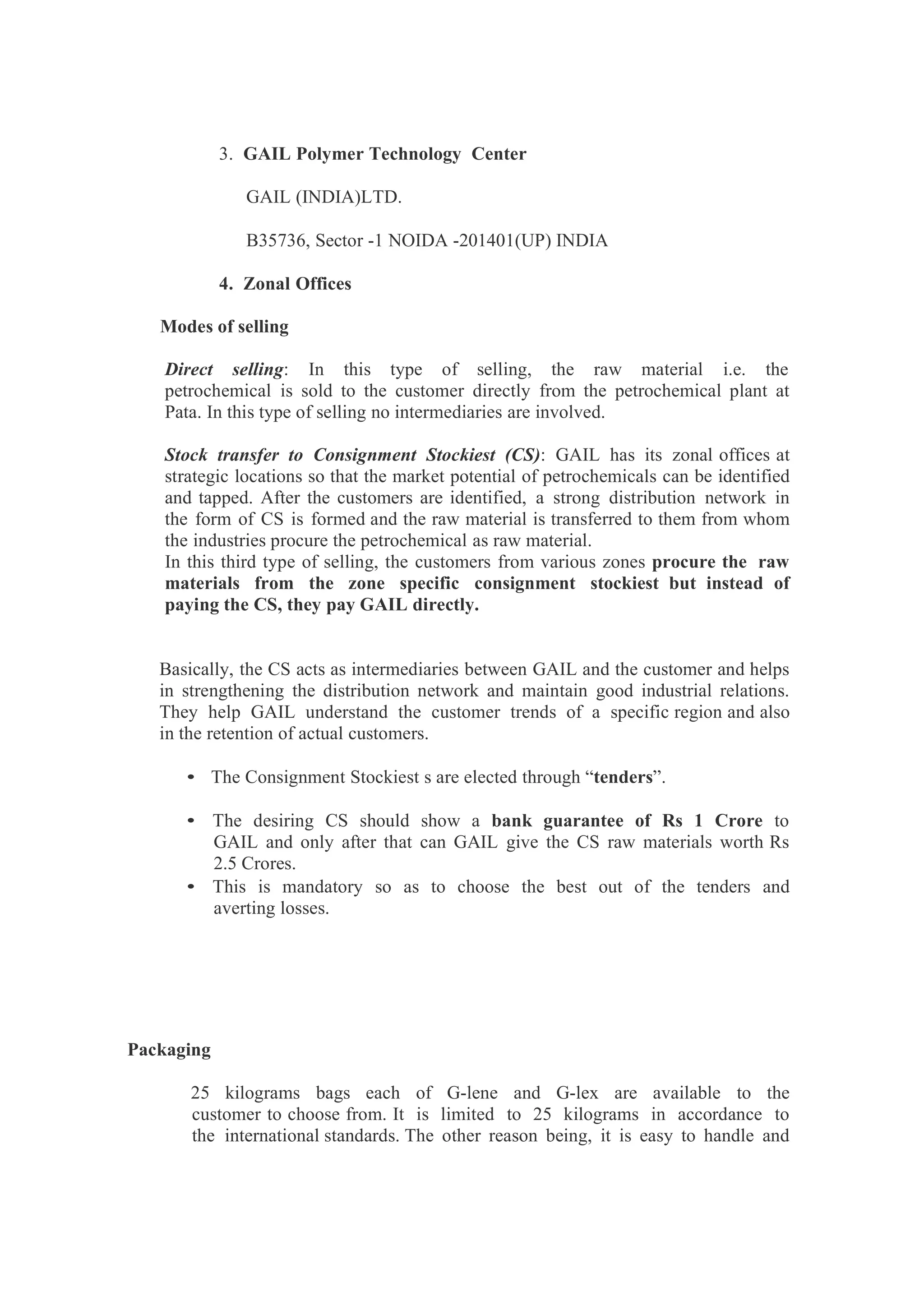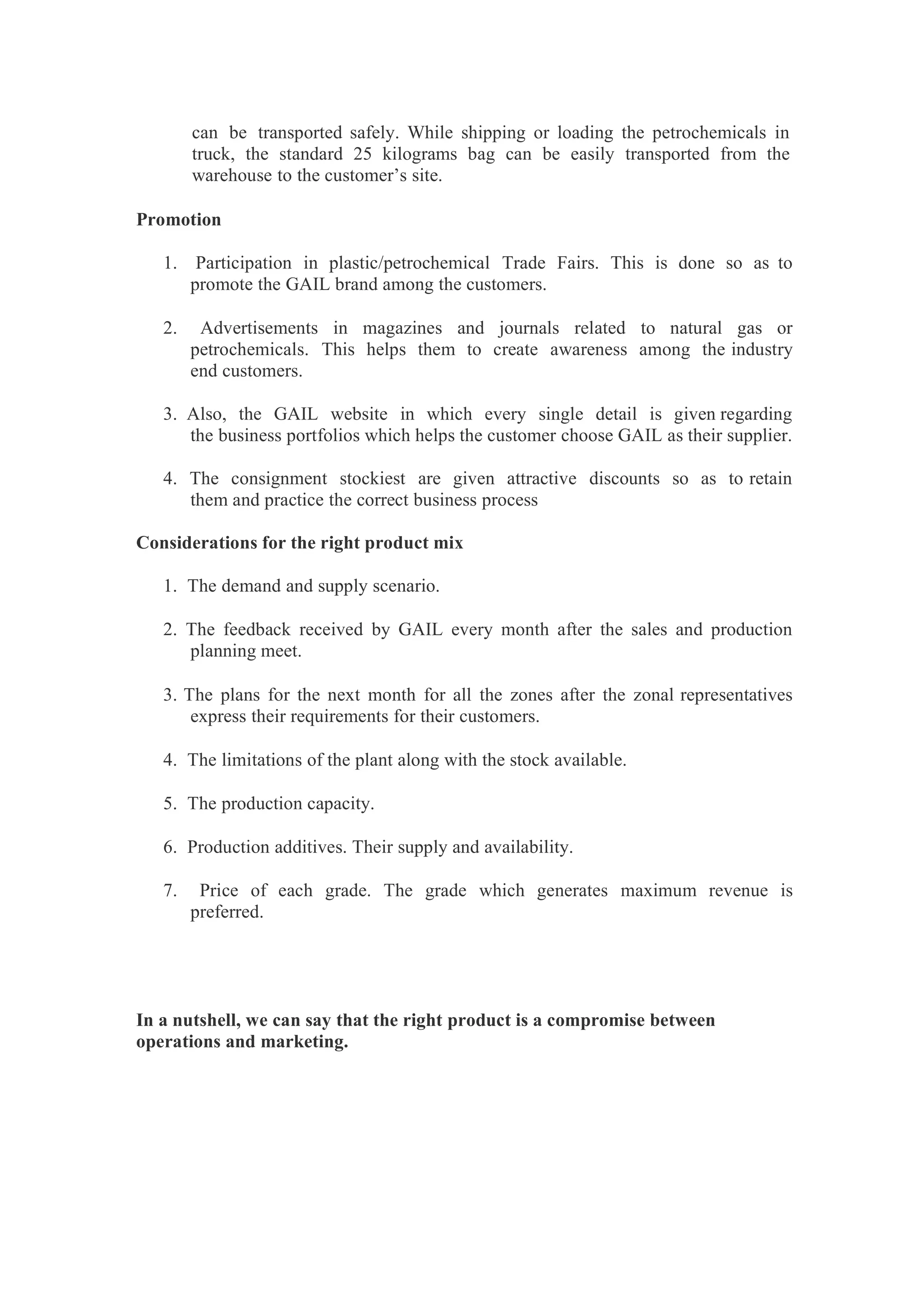This document provides a summary of GAIL (India) Limited, including its vision, mission, objectives, and key business areas. It discusses GAIL's natural gas marketing and transmission activities through its extensive pipeline network. It also summarizes GAIL's involvement in other businesses like petrochemicals, liquefied natural gas, city gas distribution, power generation, and exploration and production. The document reviews GAIL's approach and methodology for analyzing its existing marketing practices and strategies. It provides an overview of GAIL's customers, contracts, and competition in the Indian natural gas market.




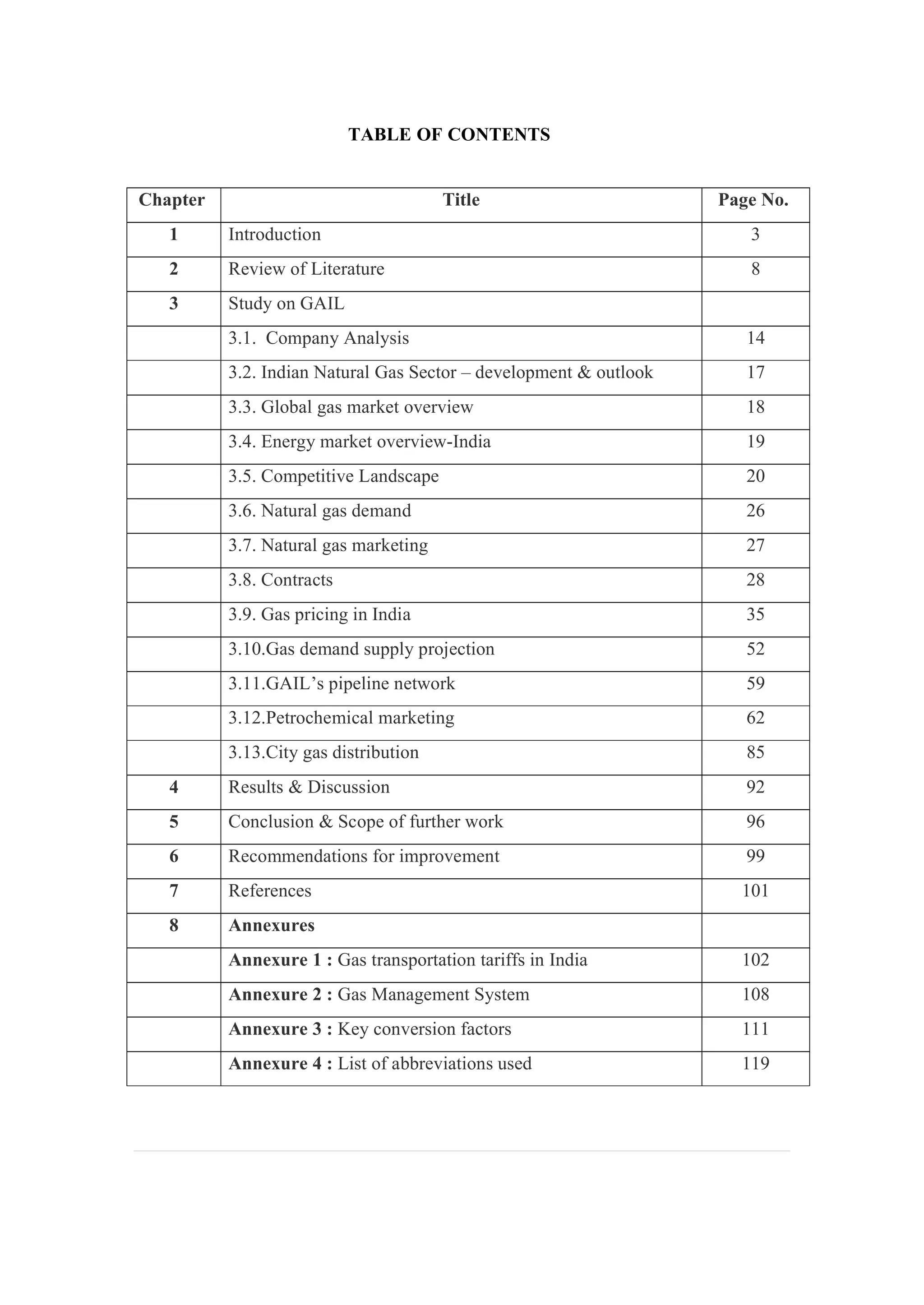
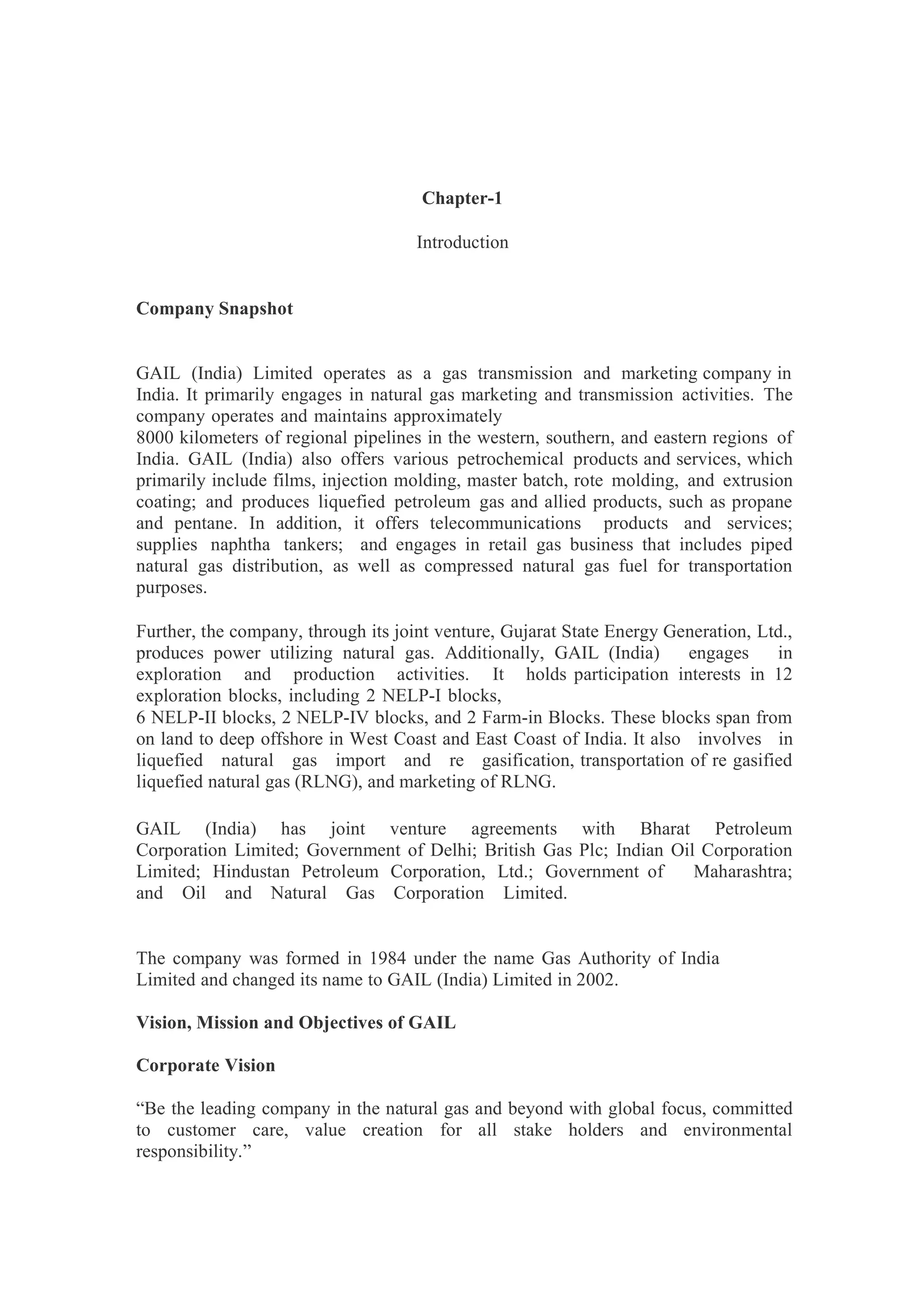



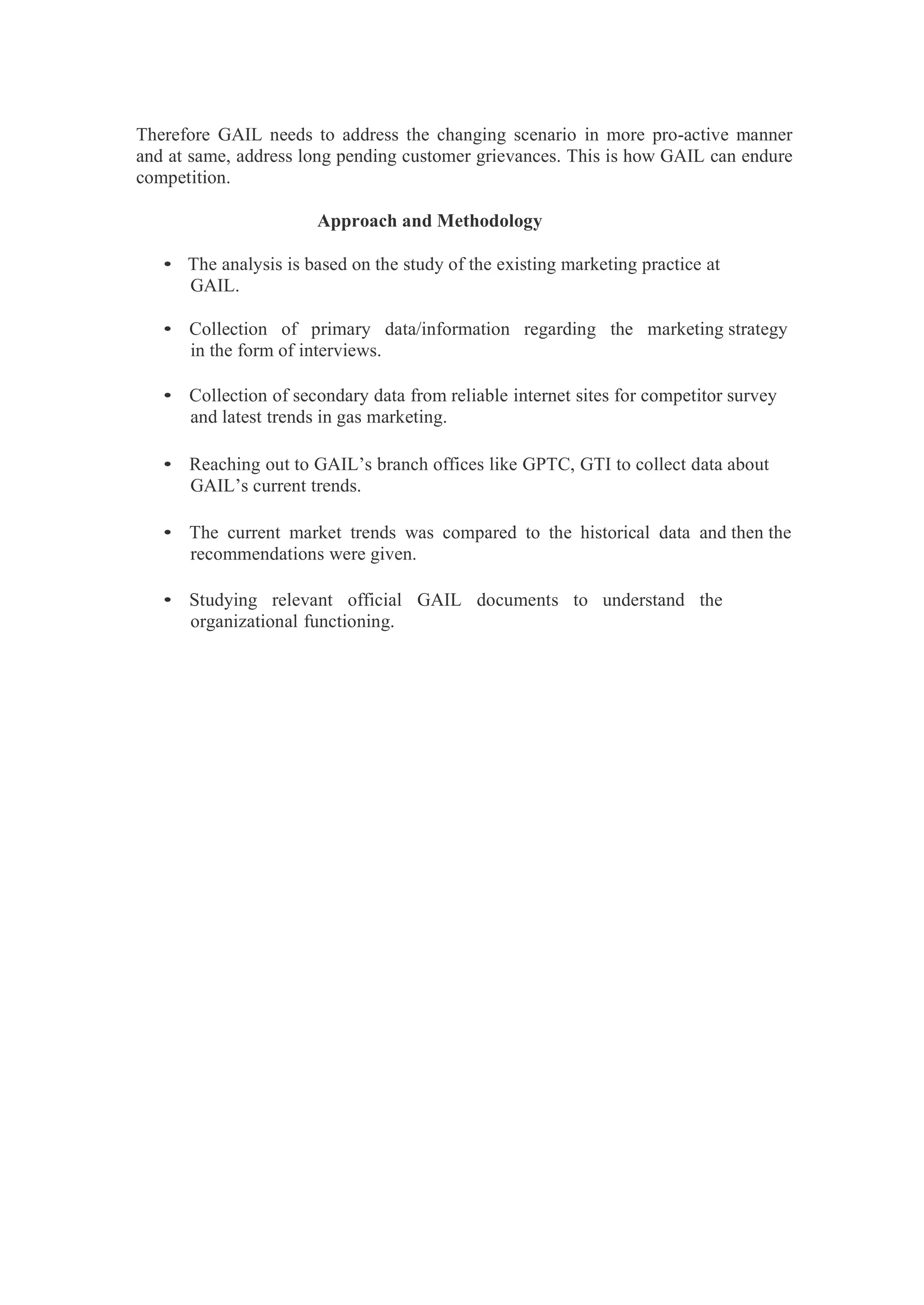


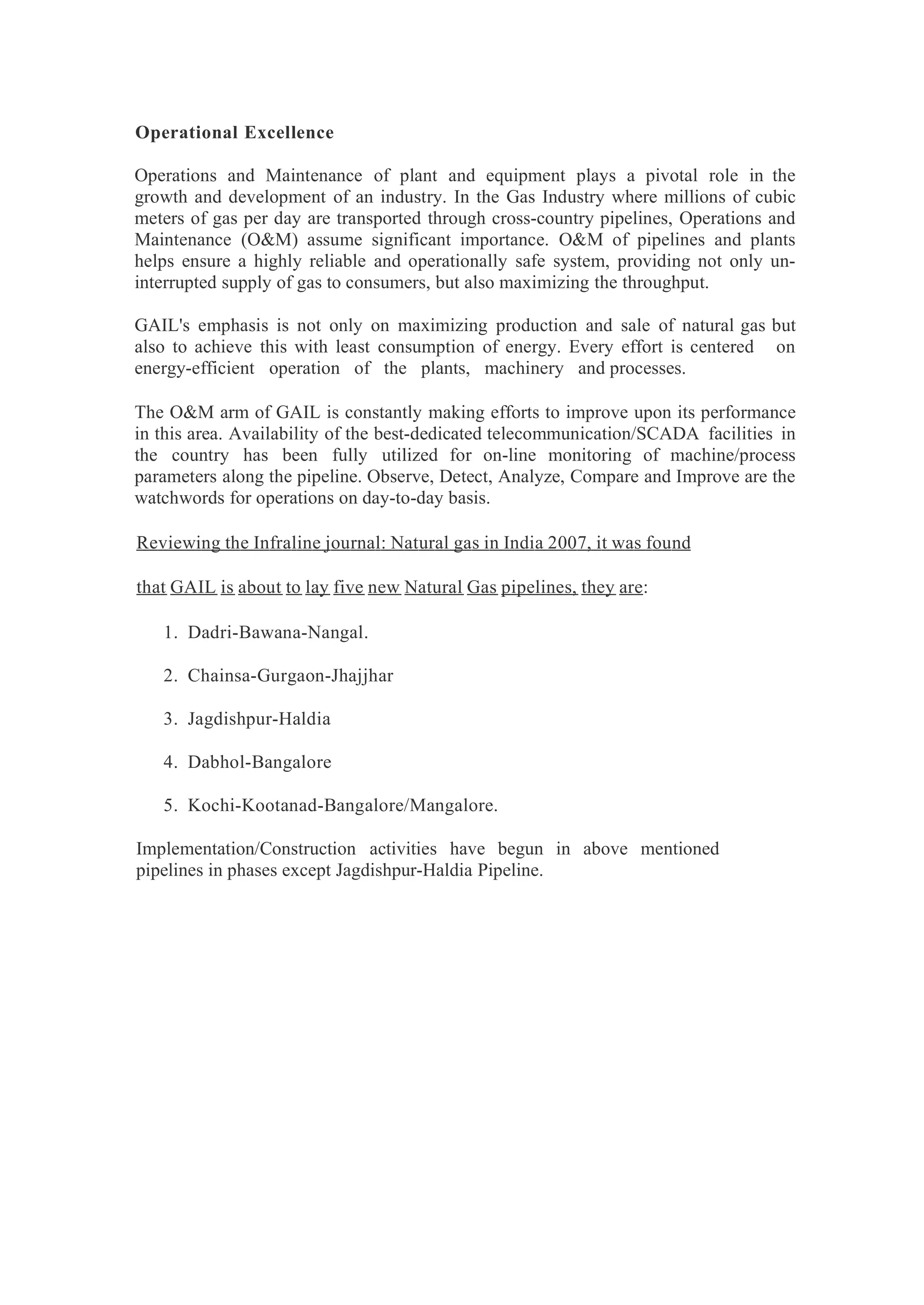
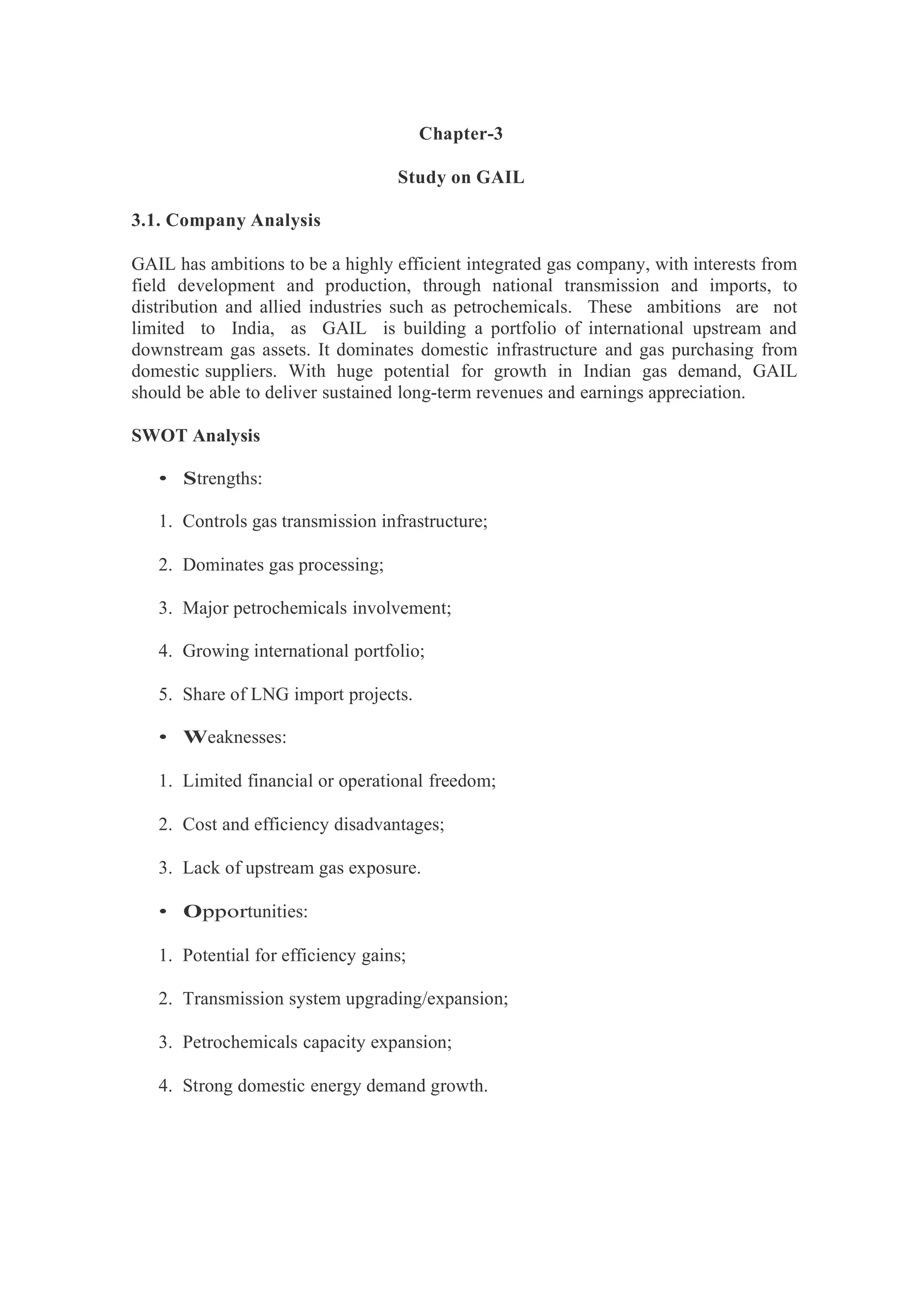









![specifications including specifying the buyer and seller, the price, the amount of
natural gas to be sold (usually expressed in a volume per day), the receipt and delivery
point, the tenure of the contract (usually expressed in number of days, beginning on
a specified day), and other terms and conditions. The special terms and conditions
usually outline such things as the payment dates, quality specifications for the natural
gas to be sold, and any other specifications agreed to by both parties.
At GAIL, there are three different types of contracts for the Gas to be marketed:
1. APM Contract
2. R-LNG Contract
3. PMT Contract
PMT contract-Features
SALE AND PURCHASE OF GAS
• Sellers agree to deliver, on a Daily basis, to the Buyer one hundred percent (100%)
of the Deliverable Volume of Sales Gas at the Delivery Point and the Buyer,
provided the Gas is made available and tendered for delivery by the Sellers, agrees
to take and purchase, on a Daily basis, one hundred percent (100%) of the
Deliverable Volume of Sales Gas provided, however, that Sellers, at Sellers’ sole
discretion
• The Deliverable Volume on the date of execution of this Contract is 17.3
MMSCMD equivalent to [617,857 MMBTU/ Day] which Deliverable Volume
shall vary every Quarter based on the Delivery Profile. The use of MMSCMD in
this Clause 2.1(c) is for the purpose of reference only.
• Each of the Sellers shall, severally sell their respective Participating Interest
share of Sales Gas to the Buyer in the quantities set forth in this Contract and the
Buyer shall purchase from each Seller that Seller’s Participating Interest share of
Sales Gas and pay for such Sales Gas in accordance with the terms of this
Contract.
• During the Contract Period, if there is any Additional Gas from the Panna-
Mukta and Mid & South Tapti Fields that becomes available for sale then the
Sellers shall use reasonable endeavours to sell and deliver such Additional Gas
to the Buyer and the Buyer shall use reasonable endeavours to purchase and
receive the same, at the Delivery Point at the Sales Gas Price.
• On any Day, the Buyer may nominate for delivery at the Delivery Point a quantity
of Sales Gas up to the Deliverable Volume.
• In the event that the Sellers are compelled to shutdown the Sellers’ Facilities
or curtail production for reasons arising out of the Buyer’s inability to take Sales](https://image.slidesharecdn.com/242266287-case-study-on-guil-150913073942-lva1-app6892/75/242266287-case-study-on-guil-24-2048.jpg)
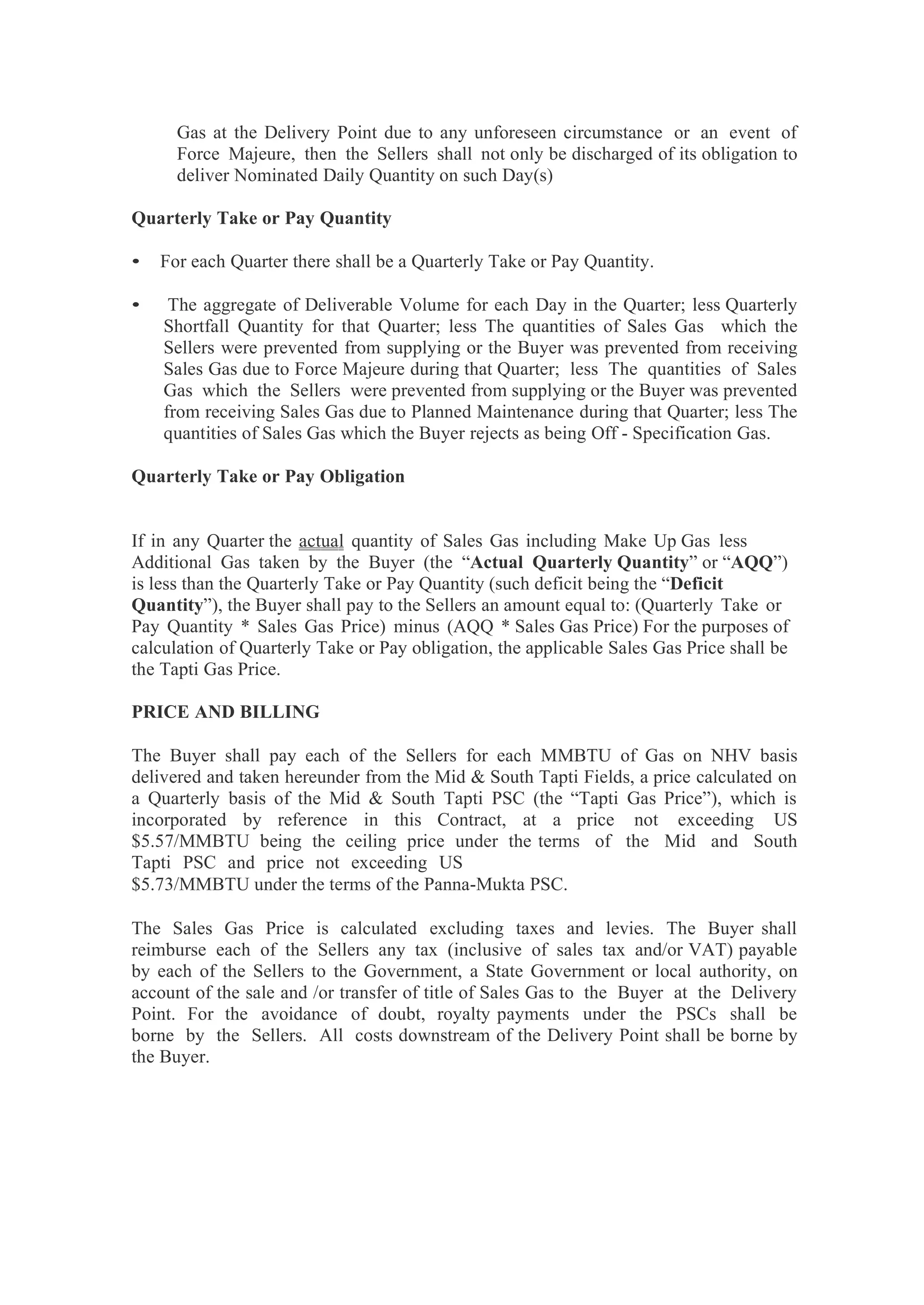
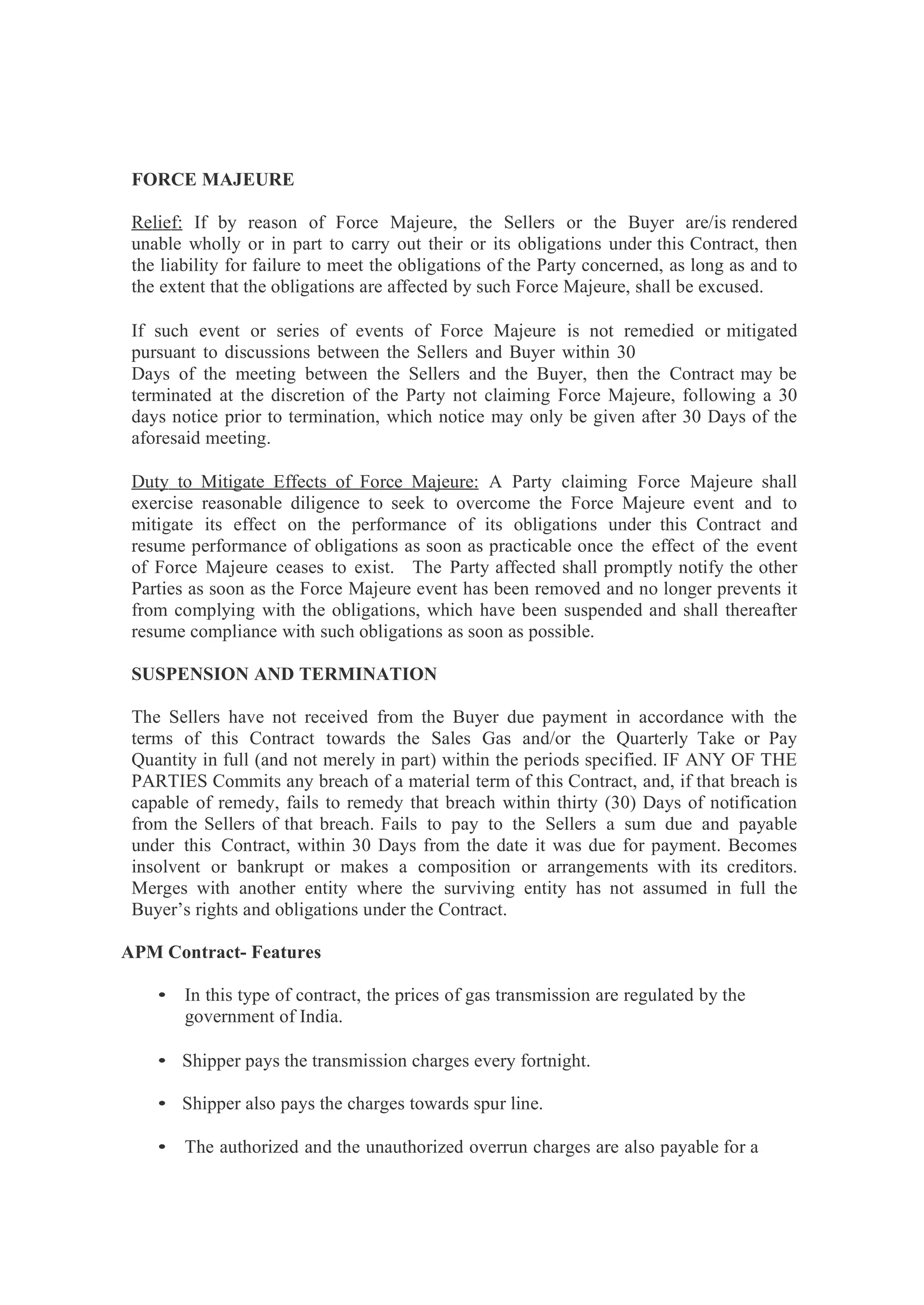
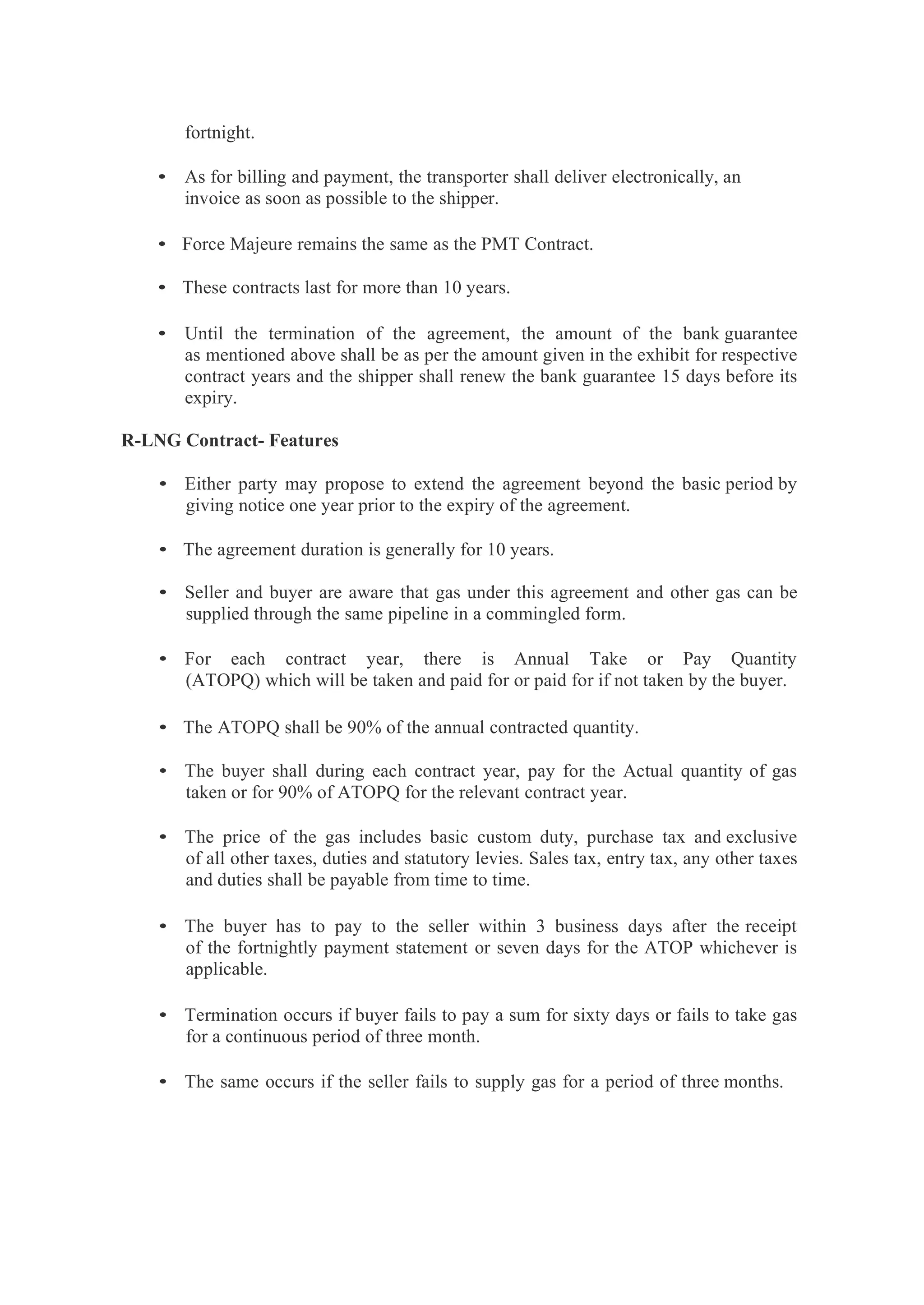


![2.3.2 It was decided that the price of gas supplied to small consumers and
transport sector (CNG) would be increased over the next 3 to 5 years to the
level of the market price. With effect from 06.06.2006, the APM gas price to
small consumers and CNG sector has been increased to Rs.4608 / MSCM.
2.3.3 It was decided that the gas price to the consumers other than those
stated in para 2.3.1, which were hitherto getting gas at APM price through
GAIL network, would be market determined.
Existing Producer Price & Consumer Price
Majority of Gas produced by ONGC, known as APM gas, is currently sold to
GAIL of the price regulated by the Government. This price at which ONGC sells
gas to GAIL is known as producer price. The price of this gas does not vary state
wise/offshore areas, instead varies for North East Consumers and General
Consumers (other than North East Consumers). The price at which GAIL sells
the gas procured from ONGC, is called consumer price.
3. Pricing of R-LNG
A contract was signed with Rasgas, Qatar for supply of 5 MMTPA LNG
(equivalent to about 18 MMSCMD] by Petronet LNG Limited and supplies
were commenced from April 2004. The price for LNG has been linked to
JCC crude oil under an agreed formula. However, the FOB price for the period
up to December 2008 has been agreed at a constant price of $2.53/MMBTU.
This price translates to RLNG price of $3.86/MMBTU ex-Dahej terminal.
In order to make the price of RLNG affordable, EGoM has decided in the
meeting held on 11.1.07 for pooling of prices of 5 MMTPA RLNG
presently being imported from Qatar with the price of new RLNG being
imported on term contract basis. This Ministry accordingly issued orders on
6.3.07, in consultation with Ministry of Law, in compliance with the decision of
EGoM. The pool price ex- Dahej of RLNG for various consumers would
be about US$
4.92/MMBTU.
4. Pricing of Gas under Pre-NELP Production Sharing Contracts - PMT
and Ravva JV Gas
4.1 Production Sharing Contracts were executed by GOI with Ravva consortium
and PMT consortium on October 28, 1994 and December
12, 1994 respectively. PSCs contain the following pricing provisions: (in
$/MMBTU)](https://image.slidesharecdn.com/242266287-case-study-on-guil-150913073942-lva1-app6892/75/242266287-case-study-on-guil-30-2048.jpg)

